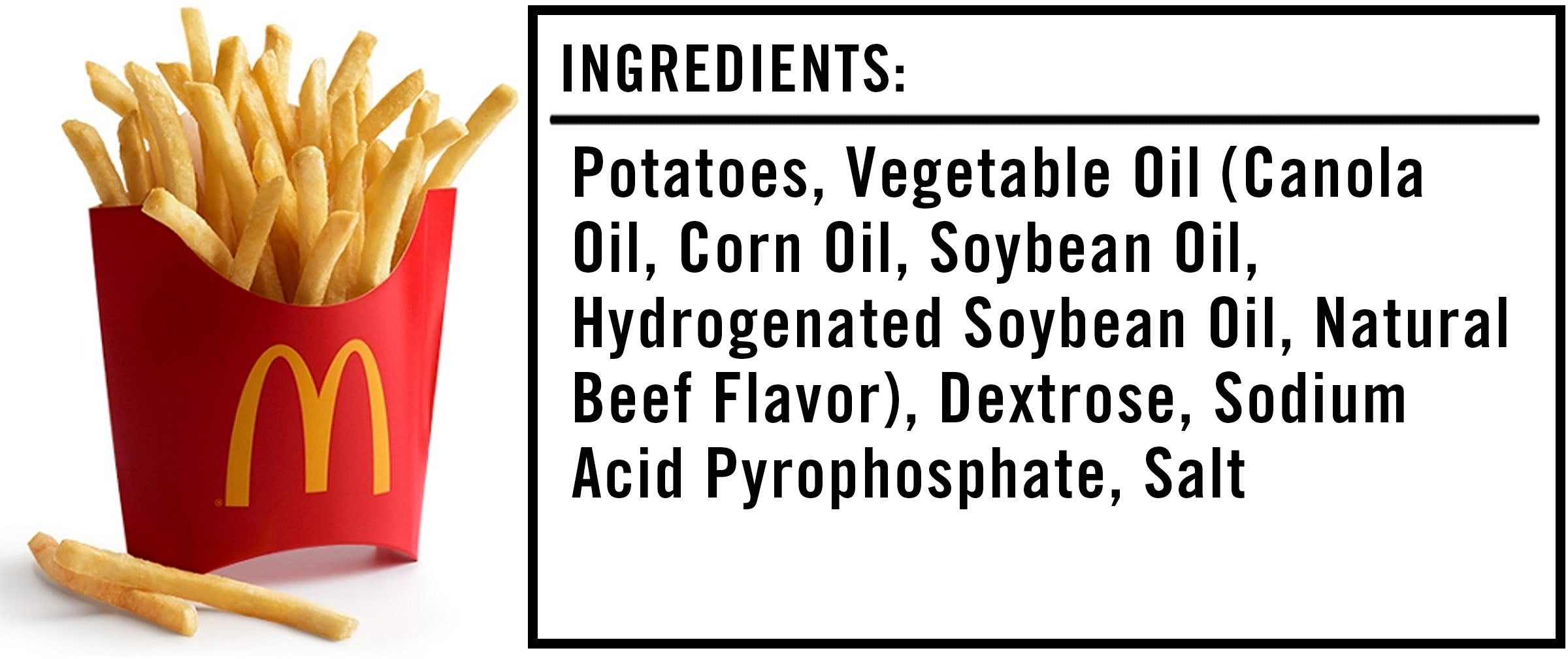We’re often told that you should never eat anything (or put anything on your body) if you don’t recognize everything on the ingredients list. But since most of us have no idea what xanthan gum or potassium benzoate are — or more importantly, what they’re doing to our bodies — we’re decoding the ingredients in the many things Americans put in (and on, or near) themselves with the help of an expert.
This edition: McDonald’s Fries, which are made from five separate ingredients, some of which have whole other ingredients lists of their own, that we’ve broken down in the exact order they appear online.
 Ingredients in McDonald’s Fries
Ingredients in McDonald’s Fries
1) Potatoes: These grow in the ground and come in many forms.
2) Vegetable Oil (Canola Oil, Corn Oil, Soybean Oil, Hydrogenated Soybean Oil, Natural Beef Flavor): Physician and biochemist Cate Shanahan, author of Deep Nutrition: Why Your Genes Need Traditional Food, previously told me that consuming too much vegetable oil — which is easy to do, considering she says roughly 45 percent of the average American’s calories come from refined oils — has serious repercussions, like fatty liver disease, insulin resistance and migraines. While it’s near impossible to eliminate vegetable oil from your diet altogether — major contributors include processed foods, fried foods, frozen pizzas, cakes, cookies, margarines and coffee creamers — it’s best consumed in moderation.
Hydrogenated vegetable oils are even worse: When you add hydrogen to food via hydrogenation — which many manufacturers do to increase the food’s shelf life — you get trans fats. Unfortunately, trans fats raise cholesterol, harden arteries and inhibit the formation of an enzyme called cyclooxygenase, which helps determine the dilation of your arteries and regulates blood flow.
McDonald’s also notes that the natural beef flavor “contains hydrolyzed wheat and hydrolyzed milk as starting ingredients.” The process of hydrolysis basically involves breaking down compounds (wheat and milk, in this case) into their individual components, which can then be used as flavor enhancers. But these ingredients probably aren’t really worth worrying about.
3) Dextrose: Dextrose is a sugar derived from starches, like wheat. Fun fact: Dextrose has a high glycemic index, meaning it quickly raises the blood sugar levels, so it’s used in IV solutions to treat low blood sugar and dehydration. People with diabetes might also consume dextrose tablets to raise their blood sugar levels if they become dangerously low.
4) Sodium Acid Pyrophosphate: While this ingredient is primarily added for the purpose of preventing the potatoes from turning brown while frying, sodium acid pyrophosphate also reduces levels of a carcinogen called acrylamide, according to the Center for Science in the Public Interest. On the flip side, studies have linked this ingredient with a weakened immune system when consumed in large amounts over an extended period of time. More generally, consuming too much phosphorus, the basis of this ingredient, contributes to osteoporosis, so maybe stick with a small order of fries.
5) Salt: I must say, I was assuming these fries would be riddled with salt, but a small order only contains 160 milligrams and a large only 350. Which is pretty weird, considering you can order a salad from McDonald’s that boasts a whopping 1,070 milligrams. For perspective, the American Heart Association recommends consuming no more than 2,300 milligrams per day, and in an ideal world, they say most adults should stay below 1,500 milligrams.
The Takeaway
Before I have my final say about McDonald’s fries, it’s also worth noting that the oil they’re fried in contains TBHQ (or tertiary butylhydroquinone) and citric acid, both of which are preservatives, as well as dimethylpolysiloxane, an antifoaming agent that prevents oil from splattering.
Studies cited by the Centers for Science in the Public Interest found that TBHQ promotes the growth of tumors in rats, and the National Library of Medicine says that vision disturbances have been reported by humans after consuming the preservative. While the FDA only allows TBHQ to be added in small amounts, this is still an ingredient to be wary of.
Citric acid, meanwhile, is generally harmless. Dimethylpolysiloxane is also “generally recognized as safe” by the FDA, although they emphasize the importance of only using antifoaming agents in small amounts:
“The quantity of any substance employed in the formulation of defoaming agents does not exceed the amount reasonably required to accomplish the intended physical or technical effect in the defoaming agents or any limitation further provided.”
Still, nutritionist David Friedman, author of Food Sanity: How to Eat in a World of Fads and Fiction, previously told me everyone should avoid foods containing dimethylpolysiloxane when possible.
All of which is to say, while I was surprised at how little salt was in McDonald’s fries, the fact is, they go hard on the artery-clogging oils and potentially dangerous preservatives. But again, we’re talking about McDonald’s fries here, and frankly, I expected a whole lot worse.

